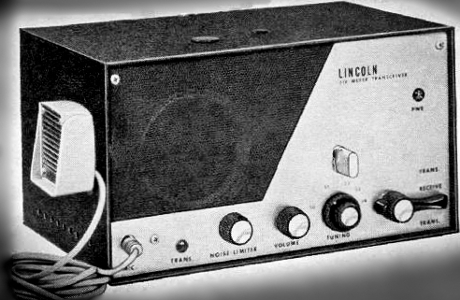Lincoln
Lincoln 6m Transceiver
 This fully assembled transceiver was sold by Allied Radio for just under $30 in 1961.
This fully assembled transceiver was sold by Allied Radio for just under $30 in 1961.
The transmitter portion uses a dual section 6CX8 tube. The triode section is an overtone crystal oscillator. The pentode section is a power amplifier with 1½ to 2 watts output. A 12AX7 sees duty as a TX speech amplifier and for receiver audio. A 6V6GT serves as the RX audio output and TX modulator.
The single conversion receiver section uses two type 6U8A dual section tubes. (RF amp, IF amp, LO & mixer) The ubiquitous 6AL5 is used in an adjustable series-gate noise limiter circuit.
The Lincoln came with a crystal microphone which was cheap but sounded decent if the transmitter was properly adjusted. My Lincoln came supplied with a transmit crystal for 50.2 Mcs.
It was important to adjust the overtone oscillator for an output level well below maximum in order to avoid pulling the TX frequency (FM) or even losing oscillator output altogether on modulation peaks.
Another issue was oscillator cessation caused by temperature changes experienced during a long transmission. The Lincoln was most certainly a flawed product. The Stinkin' Lincoln nickname was very well deserved!
It's primary competition was the Heathkit Sixer, which used a more sensible 8 Mc transmit crystal oscillator and had better transmit audio. Because the Lincoln used a two-tube receiver, it's performance wasn't much better than the Sixer's humble super-regenerative receiver design. However, the Lincoln had somewhat better selectivity despite its high IF frequency.
The one advantage of the Lincoln was it's suitability for upgrades and modifications. This was thanks to a hefty power transformer and generous interior space.
Here is a list of improvements made to my Lincoln:
- First and foremost ➙ an 8 Mc oscillator/tripler stage
- Push To Talk
- Modified the speech amplifier circuit to accommodate a Turner 350 microphone.
- A combination edgewise S/RF output meter. Using the front panel neon bulb for TX tune-up was a bad idea because the lamp didn't change brightness much. Instead, it changed color as the TX output level varied!
- Added a Nuvistor RX pre-amplifier, which provided two receiver improvements.
- The receiver noise figure was improved by a few db. (always a good thing at VHF!)
- Secondly, the additional gain lowered the AGC threshold so one AF GAIN setting was good for weak as well as strong signals.
After these changes, the Lincoln was a sweet rig. I have many fond memories of using it for extended ragchew QSOs. BTW, the Lincoln was an 8th grade graduation gift from my parents, who would tease me about monopolizing the low band station so dad couldn't get any air time. ...I think they were kidding!
The Lincoln served me well for local QSOs until the mid-60's when the sunspot cycle improved and there were a lot of band openings. The Lincoln's simple receiver was unable to separate the wall-to-wall AM stations present during these openings. It was possible to obtain Q5 copy on several transmissions from widely separated AM stations without hearing a beat note from their carriers! 
I ended up using a homebrew plate modulated 6146 transmitter into a Telrex yagi. Receiving was done on a Tecraft converter into a Hammarlund HQ-145 used as a tuneable IF.
 73 ➙ George K9GDT
73 ➙ George K9GDT
 Return to Radio Pictures
Return to Radio Pictures
 Return to MCRN Home
Return to MCRN Home
![]()
 73 ➙ George K9GDT
73 ➙ George K9GDT This fully assembled transceiver was sold by Allied Radio for just under $30 in 1961.
This fully assembled transceiver was sold by Allied Radio for just under $30 in 1961.